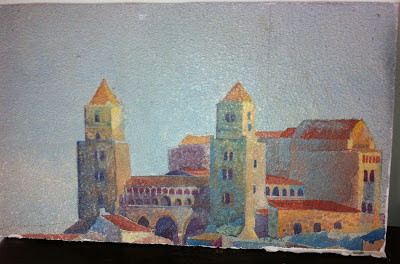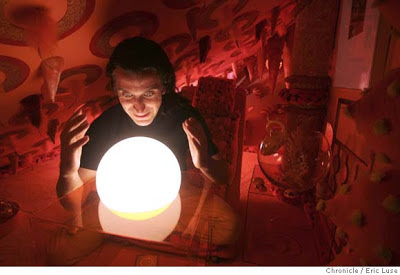I have a piece of San Fernando Valley
history and culture hanging in my garage; it’s a portion of the original mural
that graced the main wall in the old Vitello’s restaurant on Tujunga Avenue in
Studio City. It’s a painting of
the Sicilian fishing village of Cefalu where the former owners, Steve and Joe
Restivo were born. They had bought
the original restaurant from Sal Vitello in 1977 and had the mural painted, and
it stayed there for 35 years. The
current owner then bought the restaurant and renovated it by opening up the
front wall to the street and making it feel more like a contemporary Italian
bistro. But when the wall came
down, so did the mural, and the best parts of the mural ended up with me.
 |
| the original mural |
 |
| my piece of the mural |
Things
must change, and Vitello’s is better for it in my opinion, but the old version
of Vitello’s had its charms. It was the classic red Italian restaurant - the
booths, the tablecloths, the sauce and the wine were all red, with old school
American Italian items on the menu that you only hear being ordered in a movie,
like Braciole (pronounced Brazhul), which is meat wrapped in meat.
No matter where you are from, there is
a version of this Italian restaurant in your hometown. Back in San Francisco where I grew up,
it’s Original Joe’s, which had branches throughout the City. When we lived in the Sunset District,
the family would head out on Sunday night to Joe’s of Lakeside for spaghetti
and meatballs.
The
San Fernando Valley gets a bad rap for having no culture, but we have plenty
going on. However, it’s also true that we tend to celebrate odd vestiges of
1950‘s through 1970‘s American Suburbia as if they were European Renaissance
Treasures. Thus, I love my piece of Vitello’s mural, as if it were a portion of
Da Vinci’s Last Supper.
The
old version of Vitello’s also had perfect kitsch. Photos of celebrities graced
the interior foyer, like Frankie Muniz and Garry Marshall. In Brooklyn, the same kind of
restaurant would have framed and signed photos of Tony Bennett and Frankie
Valli.
Vitello’s
became notorious nationwide in 2001, when Robert Blake’s wife Bonny Lee Bakley
was found shot dead a block away from the restaurant after the couple had eaten
there. Blake, a regular, had returned to the restaurant because he had
forgotten his gun in his usual booth.
When he went back out to the car, he says that he found her shot dead,
and he was acquitted of her murder.
My
wife Robin and I loved to go to the old Vitello’s and Steve, the more
gregarious of the two brothers, would always come by and say hello and
chat. I had read in the press that
they despised the notoriety, so it wasn’t until I felt that Steve had accepted
me as a regular that I dared to ask him about it. He pointed out which one was
Blake’s regular booth and from then on he’d seat us there -- right under an oil
painting of an Italian lute player and next to the closet with the vacuum,
broom and pungent cleaning supplies, covered up by just a red curtain on a
wooden rod. The seat in the booth
had come loose so if you sat on the edge it would pop up in back. But the wine
was decent, Robin loved the pizzetti, and I liked the fettuccine with
artichokes and steak.
In
2003, when we thought we were close to starting a family, Robin and I realized
we probably wouldn’t get to travel in a big way for many years so we should go
have an adventure somewhere.
However, it had to be right away. We had both finished shows early and
didn’t have our next jobs starting for several weeks, so we had to plan a trip
and go on a trip within days -- we just didn’t know where we wanted to go.
That
night we went to Vitello’s to make plans and Steve overhead us talking and
asked us where we were going.
“We
don’t know, where should we go?”
Robin asked.
“You
should go to Sicily,” Steve said.
“Where
should we go in Sicily?” Robin asked.
“You
should go to Cefalu, where my brother and I were born!” said Steve, and pointed
at the gigantic mural on the wall behind us. It looked like a make-believe medieval storybook town, on
the water below a towering mountain.
“Does
it really look like that?” I asked.
“Of
course it does! I’ll give you the name and phone number of my relatives there,
you must call them. When are you
leaving?” he asked.
We
followed Steve’s advice. We bought
tickets on Thursday and we went to Sicily on Saturday. We were there for two
weeks, winging the whole trip, getting lost constantly but eventually driving
around the entire island.
 |
| Cefalu |
Sicily
is on the same latitude as Central and Southern California, so it looks and
feels the same in many places. The center of the island has rolling green and
yellow hillsides that look like the Salinas Valley, and the coast has towering
hills that crash down into the Mediterranean sea, like Big Sur. Many Sicilians came to California too;
some childhood friends came back to me when I saw their names on the town signs
-- Mazzarino, Randazzo, Trapani.
Sicilians
are tough people who give you the cold shoulder and a stare down for the first
30 minutes, and then after a meal and a drink they become your best friend and
want to spend time with you. We would arrive in a town and pick a restaurant,
and then after dinner the owners would insist that we come back and dine with
them every night while we were there and that they’d cook special meals just
for us. We complied, and the trip
was better for it.
Outside
Syracuse we stayed on a farm where we ate dinner with the family, and the
paterfamilias leaned across the table and said in broken English, “this
American war of yours, it’s a war about oil.” Suddenly
nervous, I grabbed the Italian English dictionary and did my best to make
conversation, and it worked. Three
hours later we were polishing off a bottle of limoncello, and they were refusrf
to let us leave the table.
Steve
was right; Cefalu was the best town (at least for us) and we were stunned that
the town looked exactly like the famous mural back in Studio City. The centerpiece of Cefalu is the
cathedral. It was built by the invading Normans who came to drive out the Moors,
during a time when every town was reinforced to withstand attack by the next
conquering army rolling through.
Thus the cathedral looks like a castle, which I’m sure it was when the
Normans first built it.
When
we returned to Studio City we went to Vitello’s to tell Steve about our trip
and he was crushed because we hadn’t eaten dinner with his relatives. We had called once but couldn’t
communicate well, we couldn’t reach the right sister, we didn’t think it was
crucial, and then we got occupied with our own vacation adventure -- but Steve
remained distant. After all, he is Sicilian. It took awhile for him to
forgive us, but he did.
When
the new owner decided to renovate, I begged him for part of the mural and he
kindly obliged. The
mural is just acrylic paint on drywall so it’s not built to last the centuries,
but I got some good pieces,including the section with the Norman cathedral that
rises above the town. Each piece is too heavy to frame and too big to hang in
the house, so I have them arranged on the walls of the garage. The pieces remind me of the Italian
restaurants from my youth, then of Sicily, which reminds me then again of
California, and we come again full circle. All I need now is a red booth.

















